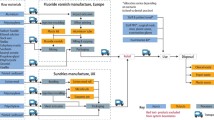Abstract
Introduction Community-level interventions for the prevention of dental caries in children include fluoride varnish in schools, supervised toothbrushing in schools, the provision of toothbrushes and toothpaste and water fluoridation. The environmental impact of these interventions is an important factor to consider when commissioning these services.
Materials and methods A comparative life cycle assessment (LCA) was conducted to quantify the environmental impact of fluoridation of the public water supply for a five-year-old child over a one-year period. These results were compared to LCA data for fluoride varnish in schools, supervised toothbrushing and the provision of toothbrushes and toothpaste.
Results When comparing community-level caries prevention programmes, water fluoridation had the lowest environmental impact in all 16 categories and had the lowest disability-adjusted life years impact.
Discussion All community-level caries prevention programmes have an associated environmental cost. Water fluoridation performed well in this LCA study in all measures of environmental sustainability. The results of this study could be used, along with cost and clinical effectiveness data, to inform public healthcare policy.
Key points
-
This paper is the final part of a three-part series looking at the environmental impact of different community-level caries prevention programmes.
-
This paper quantifies the environmental impact of water fluoridation and compares it to results from part one (fluoride varnish application) and part two (toothbrushing programmes).
-
This paper suggests how sustainability data can be used alongside clinical and cost effectiveness to make decisions about prevention at a population level.
This is a preview of subscription content, access via your institution
Access options
Subscribe to this journal
Receive 24 print issues and online access
$259.00 per year
only $10.79 per issue
Buy this article
- Purchase on Springer Link
- Instant access to full article PDF
Prices may be subject to local taxes which are calculated during checkout





Similar content being viewed by others
References
UK Government. Delivering better oral health: an evidence-based toolkit for prevention. 2021. Available at https://www.gov.uk/government/publications/delivering-better-oral-health-an-evidence-based-toolkit-for-prevention (accessed September 2021).
Centre for Disease Control. Ten Great Public Health Achievements - United States, 1900-1999. 2001. Available at https://www.cdc.gov/mmwr/preview/mmwrhtml/00056796.htm (accessed October 2021).
Iheozor-Ejiofor Z, Worthington H V, Walsh T et al. Water fluoridation for the prevention of dental caries. Cochrane Database Syst Rev 2015, DOI: 10.1002/14651858.CD010856.pub2.
Health and Safety Executive. Fluoridation - FAQs. 2021. Available at https://www.hse.ie/eng/services/list/1/environ/fluoridation---faqs-1-.pdf (accessed October 2021).
Citizens Information. Census of population. 2016. Available at https://www.citizensinformation.ie/en/government_in_ireland/national_government/copy_of_census.html (accessed October 2021).
International Organization for Standardization. ISO 14001: 2015 Environmental management systems - Requirements with guidance for use. 2015. Available at https://www.iso.org/standard/60857.html (accessed September 2021).
European Commission. Product Environmental Footprint Category Rules Guidance. 2018. Available at https://ec.europa.eu/environment/eussd/smgp/pdf/PEFCR_guidance_v6.3.pdf (accessed September 2021).
UK Government. Improving the oral health of children: cost effective commissioning. 2016. Available at https://www.gov.uk/government/publications/improving-the-oral-health-of-children-cost-effective-commissioning (accessed October 2021).
The Irish Expert Body on Fluorides and Health. What is the cost of water fluoridation? 2021. Available at https://www.fluoridesandhealth.ie/faqs/#:~:text=In%20Ireland%2C%20around%20%E2%82%AC5.0,at%20Water%20Treatment%20Plants%20annually.&text=1%20%22Water%20Fluoridation%20Cost%20%E2%82%AC,M%20Last%20Year%20%E2%80%94%20Doh%22 (accessed September 2021).
Google. Search for 'water fluoridation is bad for the environment'. 2021. Available at https://www.google.com/search?sxsrf=AOaemvIfZg2-fbG0FMfuyh-YIuKONRyI5A:163354water+fluoridation+is+bad+for+the+environment&sa=X&ved=2ahUKEwiHvavwqLbzAhXQilwKHRHgASIQgwN6BAgBEAE&biw=1440&bih=764&dpr=2 (accessed October 2021).
Acknowledgements
The authors would like to thank the individuals and organisations that provided information about the process of water fluoridation in Ireland.
Funding
This study received no external funding.
Author information
Authors and Affiliations
Contributions
Brett Duane lead the data collection and analysis and drafted/revised the paper. Alexandra Lyne contributed to data collection and analysis and drafted/revised the paper. Ray Parle contributed to data collection and revised the paper. Paul Ashley drafted the manuscript and revised the paper.
Corresponding author
Ethics declarations
The authors declare no conflict of interest.
This paper was a mathematical/analytical analysis of the environmental impact of water fluoridation, hence no ethical approval was required.
Rights and permissions
About this article
Cite this article
Duane, B., Lyne, A., Parle, R. et al. The environmental impact of community caries prevention - part 3: water fluoridation. Br Dent J 233, 303–307 (2022). https://doi.org/10.1038/s41415-022-4251-5
Received:
Accepted:
Published:
Issue Date:
DOI: https://doi.org/10.1038/s41415-022-4251-5
This article is cited by
-
What is the environmental footprint of a dental practice? A life cycle analysis (Part 1)
British Dental Journal (2024)
-
The three Ps in sustainability
BDJ Team (2023)



